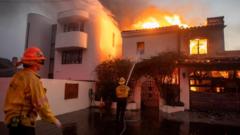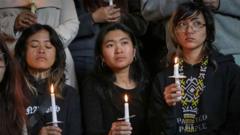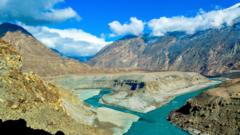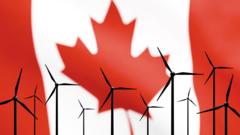Wildfires continue to devastate Los Angeles, with hundreds of buildings destroyed and over 130,000 residents evacuated. As firefighters struggle to contain the flames, concerns grow over the calamity's connection to climate change.
Los Angeles Wildfires Ignite, Causing Widespread Destruction and Evacuations

Los Angeles Wildfires Ignite, Causing Widespread Destruction and Evacuations
Destructive wildfires lead to evacuations and casualties in Los Angeles, fueled by climate change and severe weather conditions.
The recent wildfires in Los Angeles are wreaking havoc, leading to tragic losses and dramatic evacuations across the city. At least five individuals have lost their lives, with their bodies discovered near the Eaton Fire. Authorities have reported over 137,000 people forced to flee their homes, many leaving with only essential belongings.
Despite the tireless efforts of firefighters, the largest fires, such as the Eaton and Palisades Fires, remain uncontained. The Palisades Fire, which began on Tuesday, has rapidly spread to cover more than 17,200 acres, threatening the upscale Pacific Palisades area. The new Sunset Fire is also encroaching on Hollywood Hills, adding to residents' fears.
Destruction has been widespread, with more than 1,000 structures, including homes and businesses, reported lost. The onset of critical fire weather, despite a slight alleviation in severity, offers little hope as forecasters predict no substantial rain for at least a week.
Traffic disruptions abound as residents flee the flames, and several educational institutions, including UCLA, have closed their doors. Criticism has emerged over the city's firefighting preparedness, especially after reports of dry hoses during the crisis, a point highlighted by President-elect Donald Trump.
As of Thursday, California officials indicated that five primary fires are currently ravaging the region, with varying degrees of containment:
1. **Palisades Fire:** 17,200 acres burned; the most destructive in state history.
2. **Eaton Fire:** 10,600 acres affected in northern Los Angeles.
3. **Hurst Fire:** 855 acres developing north of San Fernando, showing limited containment progress.
4. **Lidia Fire:** 350 acres near Acton and currently 40% contained.
5. **Sunset Fire:** Rapidly spreading to approximately 43 acres in Hollywood Hills.
A major contributing factor to the wildfires is the Santa Ana winds, known for their strength of over 60 mph, which exacerbate fire spread, especially in dry conditions. While naturally caused wildfires are common, experts assert that human activities account for about 95% of incidents in the area.
Climate change has emerged as a significant influencer in the severity and frequency of wildfires. Government agencies indicate that the ongoing drought, increased temperatures, and the warming atmosphere are intensifying conditions conducive to such disasters. Governor Gavin Newsom expressed his concerns, stating, "There's no fire season... It's fire year," hinting at what appears to be a new normal for California fire events.
In light of the catastrophic effects of these wildfires, the urgency for sustainable environmental practices and fire management strategies becomes ever more critical.
Despite the tireless efforts of firefighters, the largest fires, such as the Eaton and Palisades Fires, remain uncontained. The Palisades Fire, which began on Tuesday, has rapidly spread to cover more than 17,200 acres, threatening the upscale Pacific Palisades area. The new Sunset Fire is also encroaching on Hollywood Hills, adding to residents' fears.
Destruction has been widespread, with more than 1,000 structures, including homes and businesses, reported lost. The onset of critical fire weather, despite a slight alleviation in severity, offers little hope as forecasters predict no substantial rain for at least a week.
Traffic disruptions abound as residents flee the flames, and several educational institutions, including UCLA, have closed their doors. Criticism has emerged over the city's firefighting preparedness, especially after reports of dry hoses during the crisis, a point highlighted by President-elect Donald Trump.
As of Thursday, California officials indicated that five primary fires are currently ravaging the region, with varying degrees of containment:
1. **Palisades Fire:** 17,200 acres burned; the most destructive in state history.
2. **Eaton Fire:** 10,600 acres affected in northern Los Angeles.
3. **Hurst Fire:** 855 acres developing north of San Fernando, showing limited containment progress.
4. **Lidia Fire:** 350 acres near Acton and currently 40% contained.
5. **Sunset Fire:** Rapidly spreading to approximately 43 acres in Hollywood Hills.
A major contributing factor to the wildfires is the Santa Ana winds, known for their strength of over 60 mph, which exacerbate fire spread, especially in dry conditions. While naturally caused wildfires are common, experts assert that human activities account for about 95% of incidents in the area.
Climate change has emerged as a significant influencer in the severity and frequency of wildfires. Government agencies indicate that the ongoing drought, increased temperatures, and the warming atmosphere are intensifying conditions conducive to such disasters. Governor Gavin Newsom expressed his concerns, stating, "There's no fire season... It's fire year," hinting at what appears to be a new normal for California fire events.
In light of the catastrophic effects of these wildfires, the urgency for sustainable environmental practices and fire management strategies becomes ever more critical.





















